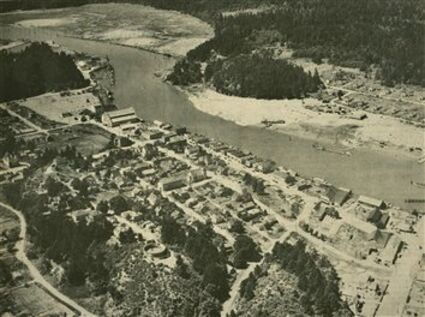Shelter Bay slips quietly past 50 year anniversary
Looking back to our past —
August 12, 2020
It was just over a half century ago that the Shelter Bay development, which some predicted would transform then sleepy La Conner into the Carmel of the Northwest, both literally and figuratively changed the local landscape.
That is when Osberg Construction of Seattle was in the midst of dredging millions of yards from what had been known as Indian Bay to create the present harbor and moorage area that serves as a visual anchor for the 420-acre planned residential community. The population now hovers near 2,000.
The Osberg firm employed large work crews and a fleet of heavy equipment for the job, clearly focused on the future but also committed to preserving the past, said Swinomish Indian Tribal Community member Dr. Wil James.
“Indian Bay was communal property, essentially a gathering place where natives would gather during big storms,” James told the Weekly News. “The current placement of the community clubhouse was originally a campsite and the building itself is designed to honor that memory.”
James compared the clubhouse, which he said marked its golden anniversary in June, to that of the three open-air pavilions above the Swinomish shoreline a bit to the north.
“It is similar in shape,” he said, “to the cedar hats.”
The Osbergs, led by their patriarch, the Swedish-born Axel Osberg – who got his start in construction helping build railroad tunnels in Canada – had in 1968 leased the scenic waterfront and upland tracts on the southeastern end of Fidalgo Island from the Swinomish Tribal Community. It was a relatively new concept in long-term land leasing and development.
That lease agreement, for what was wild marshland and rolling hills and designed to provide Swinomish annual rental incomes as it began diversifying its economy, received approval from the U.S. Bureau of Indian Affairs and the Commerce Department.
Formerly remote and recreational Indian Bay was about to morph into Shelter Bay.
“I remember going duck hunting down there in those mud dikes with my grandpa Alfred Sampson, Sr.,” recalled Kenny Paul, who grew up in Swinomish Village and now resides in Nevada. “I remember as a little kid playing with other reservation kids, going swimming and running down there when Shelter Bay used to be called ‘the flats.’
“I didn’t hunt over there,” added Don Misner, who lived in town and later in the Snee-Oosh area prior to moving to Castle Rock, “but I did waterski through there with Doug Wilbur. I figured that as long as I was with Doug, I wouldn’t get in too much trouble.”
Wilbur’s grandfather, Tandy Wilbur, Sr., along with Dewey Mitchell and other members of the Swinomish Tribal Council, were lauded by the Osbergs for the novel master lease arrangement.
Having secured the lease, which runs through 2044, the Osbergs over a two-year period planned and built the community’s amenities, adding a roadway network, swimming pools, tennis courts and golf course to go with the clubhouse and marina.
Don McCune, renowned as Seattle TV personality Captain Puget, was enlisted to promote Shelter Bay to a primarily West Coast market interested in sub-leasing lots as home sites. Many of those who showed interest did so because they viewed the development as a boater’s haven, given its proximity to the San Juan Islands.
The campaign proved effective. Fifteen houses were completed in 1971. Another 52 homes were added the following year.
Today there are nearly double the 500 homes initially projected for Shelter Bay. The community’s residents range from working families to retirees and hail from near and far.

Links between Shelter Bay’s development and La Conner area population growth and increased retail activity here were forecast from the get-go in the pages of the Puget Sound Mail, the town’s weekly newspaper.
Editor Pat O’Leary assigned columnist Bob Clifton, a retired postal inspector, to interview Osberg for a feature article. In his January 1969 account, Clifton suggested that “the business people in La Conner will certainly be busier next summer simply because there will be many who simply want to see what is going on.”
O’Leary had earlier, in the fall of 1968, covered a special meeting at which between 175 and 225 people jammed into the old Hope Island Inn to discuss potential ripple effects related to Shelter Bay.
O’Leary reported that La Conner Chamber of Commerce President Gil Larsen, a realtor and Rotarian, told those in attendance that “in the years ahead it (La Conner) faced a population explosion in its immediate area and should be making plans accordingly to adjust to this change and to preserve what the citizens want to preserve.”
One of Axel Osberg’s sons, John, sought to reassure Puget Sound Mail readers with a published report a month after the Hope Island Inn forum. That notice said it was the company’s intent to keep its “La Conner and Skagit Valley neighbors informed on our progress and future plans.”
The younger Osberg wrote that “we feel this planned development of Shelter Bay will be a source of pride to the Swinomish Community and to Skagit County.”
By 1975, enough children resided in Shelter Bay to merit a La Conner Schools bus route. The Shelter Bay Yacht Club was formed a year later.
Those moving to Shelter Bay almost immediately became part of the La Conner scene as new business owners, employees, service club officers, civic volunteers, members of various boards and panels and more. That trend has continued.
“I can say that the impact of 900 homes and a permanent population of approximately 1,900 – twice that of the town – must have had a significant positive impact to the commercial and governmental sectors of the Town of La Conner over the course of the last 50 years,” Shelter Bay Manager David Franklin said.
James stressed this example: Among the early Shelter Bay residents, he said, was Paul J. Avery, hired in 1974 as Superintendent of La Conner Schools. According to James, Avery would later join forces with his father, the legendary La Conner High teacher and coach Landy James, to create what is now Northwest Indian College.
“Shelter Bay,” said James, who serves as a liaison between the community’s board of directors and Swinomish Tribe, “has been an asset for the entire community. And in many ways, Shelter Bay continues to be an asset.”






Reader Comments(0)